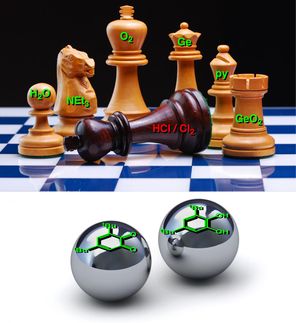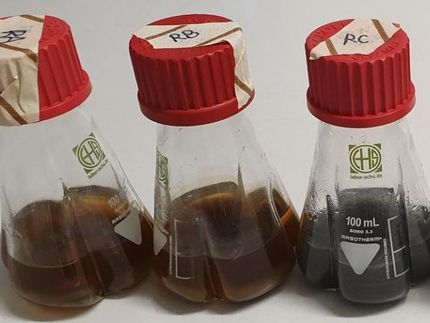On the way to emission-free mining: extracting metals with microorganisms
Innovative process for the bioleaching of copper, indium and zinc developed
microorganisms work in an underground bioreactor and convert ores or residual materials from mining into the valuable metals copper, indium and zinc. Innovative membrane filters then filter the valuable metals from the resulting process water. In a pilot plant of a current mining project near Pöhla in Saxony, a team from the TU Bergakademie Freiberg wants to combine both procedures into an innovative process. The environmentally friendly solution could make it possible to extract metals at low temperatures and directly in a mine using a process known as bioleaching.
The researchers have already trialled the two innovative processes in the laboratory. Now, thanks to funding from the European Union, they can test the environmentally friendly process on a larger scale in a pilot plant: "At a low pH value, we get the microorganisms in a bioreactor to dissolve the metals from insoluble sulphides, here for example in the minerals sphalerite and chalcopyrite. Copper, indium and zinc can then be extracted from the solution using various hydrometallurgical processes - with low energy input and without the harmful exhaust gases typical of pyrometallurgical processes," explains Professor Sabrina Hedrich, who is coordinating the international "XTRACT" research project.
Project team member Dr Roland Haseneder adds: "The microorganisms are then separated using a hybrid membrane separation process and the valuable metals are "sorted" by charge and size using selective filter units. This is preferably done by direct connection to the bioleaching process on site."
Environmentally friendly extraction of metals from poor ores
The process is therefore particularly suitable for ores or residual materials from mining that only contain low concentrations of metals - so-called lean ores. "Simply by reacting with the microorganisms, the metals can be converted into a soluble form without external energy and thus be processed. In addition, the extraction of metals from low-grade ores is very complex. The biohydrometallurgical processes have proven to be not only environmentally friendly, but also particularly suitable," says Hedrich.
In addition to the mining project in Pöhla, Saxony, these lean ores are also found in other mines in Europe. Together with the partners, the process will also be trialled in the Björkdal mine (Sweden) and for recycling mining residues in São Domingos (Portugal) and Lavrion (Greece).
About the "XTRACT" research project
The aim of XTRACT is the emission-free mine of the future with innovative micro-invasive technologies for sustainable and low-carbon mining. In this way, the research project is helping to conserve primary resources and prepare technologies for the realisation of the EU's climate neutrality targets. The processes developed in the project are suitable for poor ores as well as for dumps and contaminated sites and are therefore not only suitable as a solution for the extraction and recovery of various precious metals, but also for the remediation of mining waste. The EU's Horizon Europe research programme is funding 14 partner organisations from 9 countries (Germany, Sweden, Finland, Lithuania, Spain, Greece, France, Portugal, Cyprus) with a total of 5 million euros for the period up to December 2026.
TU Bergakademie Freiberg Institute of Biosciences and Institute of Thermal Process Engineering, Environmental and Natural Materials Process Engineering
- Lulea Tekniska Universitet (LTU)
- Muon Solutions Oy (MUON)
- Universidad de Salamanca (USAL)
- ACCELIGENCE LTD (ACCELI)
- Bureau de recherches geologiques et minieres (BRGM)
- Unparallel Innovation Lda (UNP)
- Laboratorio National de Energia e Geologia l.p. (LNEG)
- Polytechneio Kritis (TUC) Lietuvos Agrariniu Ir Misku Mokslu Centras (LAMMC)
- Lietuvos Agrariniu Ir Misku Mokslu Centras (LAMMC)
- Saxore Bergbau GmbH (SAXORE)
- Etaireia Axiopoiiseos Kai Diacheiriseos Tis Periousias Tou Ethnikou Metsoviou Polytechneiou (NTUA/AMDC)
- G.E.O.S. Ingenieurgesellschaft mbH (GEOS)
Most read news
Topics
Organizations
Other news from the department science

Get the chemical industry in your inbox
By submitting this form you agree that LUMITOS AG will send you the newsletter(s) selected above by email. Your data will not be passed on to third parties. Your data will be stored and processed in accordance with our data protection regulations. LUMITOS may contact you by email for the purpose of advertising or market and opinion surveys. You can revoke your consent at any time without giving reasons to LUMITOS AG, Ernst-Augustin-Str. 2, 12489 Berlin, Germany or by e-mail at revoke@lumitos.com with effect for the future. In addition, each email contains a link to unsubscribe from the corresponding newsletter.






























































